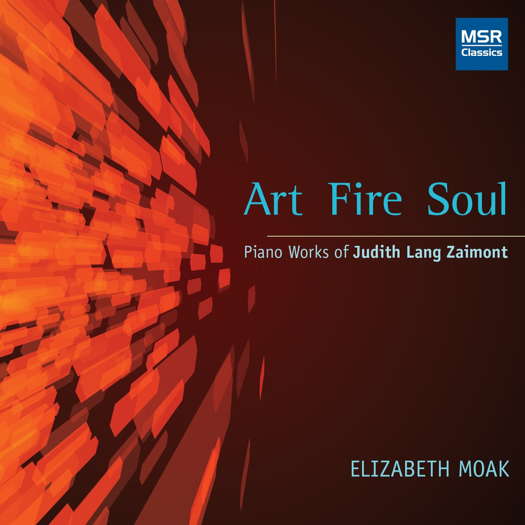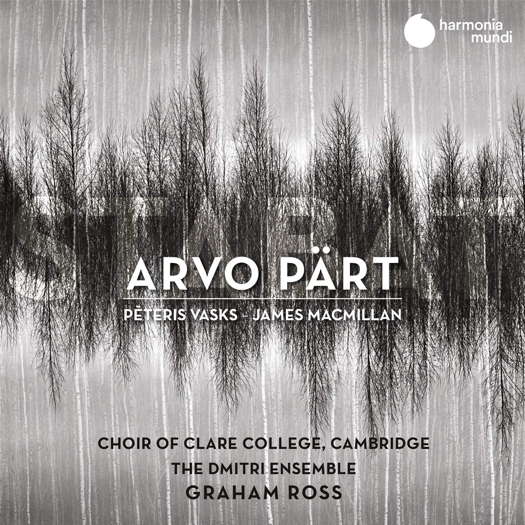 SPONSORED: CD Spotlight. An Encyclopedic Recital - Elizabeth Moak plays Judith Lang Zaimont, heard by the late Howard Smith.
SPONSORED: CD Spotlight. An Encyclopedic Recital - Elizabeth Moak plays Judith Lang Zaimont, heard by the late Howard Smith.
All sponsored features >>
 DISCUSSION: John Dante Prevedini leads a discussion about Composers, individuals or collective?, including contributions from David Arditti, Halida Dinova, Robert McCarney and Jane Stanley.
DISCUSSION: John Dante Prevedini leads a discussion about Composers, individuals or collective?, including contributions from David Arditti, Halida Dinova, Robert McCarney and Jane Stanley.
- Paul Wiffen
- Parlophone Records Ltd
- Jonathan Dove
- Ernest Berk
- Robin Holloway
- Desmond Ratcliffe
- Pia Toscano
- O2 Arena

Effervescent Beauty
Music by Pärt, Vasks and MacMillan,
sung by the Choir of Clare College, Cambridge,
impressing PATRICK MAXWELL
'This recording from the Choir of Clare College Cambridge under the direction of Graham Ross cements their position as one of the finest church ensembles in the country ...'
Arvo Pärt's distinctive tintinnabuli style has created for him a niche in the world of contemporary classical music. Whilst composers such as Philip Glass, Steve Reich and in a different way La Monte Young have explored the new ways of what became known as 'minimalism' in opera and traditional music formats, Pärt has taken on a more religious theme. His style, which became popular after the success of Für Alina in 1976, has become almost unmistakable. It evokes both the serenity, and harsh dissonance, of many themes, all based around that of deep religious experience, all composed by a man who has experienced the sight of loss as a musical exile under Soviet repression.
This recording from the Choir of Clare College Cambridge under the direction of Graham Ross cements their position as one of the finest church ensembles in the country, far outpacing the renown of King's College of the same city. This recording takes two other composers along with Pärt at the centre, with the works of Pēteris Vasks of Latvia and James MacMillan of Scotland, creating a CD that is full of the effervescent beauty which pervades all three composers' work.
The first work, Pärt's Da pacem, Domine, is based around the musical conversation of four voices, with a note from the soprano part being countered by the deep, probing harmonies below. It has some echoes of the early music that the composer studied when he forced himself into artistic exile in 1968.
The second piece, The Woman with the Alabaster Box, sets words of St Matthew, and uses the influence of a well-used minimalist device, that of drones, whereby one voice holds a note whilst others swirl around it in harmonies. The homophonic texture evokes the steps, the slow narration of Jesus' words in the bass. Textual clarity is hard at this point, but more could have been achieved for more vivid contrast between the voices. The piece, forever mixed with an inner dissonance, resolves into a serene D major.
Listen — Arvo Pärt: The Woman with the Alabaster Box
(track 2, 5:05-5:58) © 2020 harmonia mundi musique sas :
The next work is Vasks' Plainscapes, which employs a violin and cello with the choir. It is a similar sound world, but Vasks' work has a particular, brilliant idiosyncrasy that creates a more dream-like, reflective sound. The spiralling violent part builds a momentum that is searching, but not intricate. Although the work has echoes of Pärt's style, it is different in both effect and character, with no words to back up the vocal melodie, which floats around the cascading violin part, with much of the piece in a solemn piano, before the crescendo at the end and the full release of all the momentum previously build up, mixed with the sound of bird-song. This difficult effect is well produced both by the choir and by Jamie Campbell on violin with Oliver Coates on cello.
Listen — Pēteris Vasks: Plainscapes
(track 3, 12:15-13:14) © 2020 harmonia mundi musique sas :
Pärt's Magnificat follows, a piece which has been established in church choirs in Britain, surely for its brilliant use of different voices building a simple harmonic structure, the composer's intricate rhythmic structure and the devout, piercing F minor. Again, the music builds up to a number of brilliant chords which span the vocal register in D flat major. Not all of the musical technicalities needed to make each phrase shape are taken by the choir, but the general effect is made, reflecting Pärt's musical genius that relishes every note.
The Nunc dimittis that follows is similar in tone, showing the same harmonic vitality and sonority, but is not a companion piece to the Magnificat. The passage at 'lumen ad revelationem gentium' (a light to lighten the gentiles) shows an expressive Pärt at his best, building a climax that fully expounds upon the words.
Listen — Arvo Pärt: Nunc dimittis
(track 5, 4:25-5:25) © 2020 harmonia mundi musique sas :
James MacMillan has established himself as perhaps the best living composer in Britain, through his expressive and radiant pieces, despite his Mass (2000), once of the most atrocious examples of how mistreated religious minimalism can be. He is back on form with his Miserere, which fits into the overall tone of the whole recording, taking the pleading words of Psalm 51 and using the contrast of the plainsong doxology with the upper voices in much the same way as Allegri does it in his famous adaptation.
Listen — James MacMillan: Miserere
(track 6, 11:18-12:17) © 2020 harmonia mundi musique sas :
The last piece is the largest, Pärt's Stabat Mater, which uses a string orchestra, in this case The Dmitri Ensemble, of whom Graham Ross is their Principal Conductor. The piece opens with a solemn string musical conversation, before the voices join and create another of Pärt's crescendos to a climax before dying away, only to be built up again - a structure that seems to reflect the music's emotions.
This recording shows some of Pärt's most overtly religious music, and keeps to the same sound world in the music of Vasks and MacMillan. It is performed with the skill and musical awareness that have meant that Ross' choir is recognised to be, and deserves to be hailed as, one of the finest of its type.
Copyright © 27 March 2020
Patrick Maxwell,
Buckinghamshire, UK

CD INFO: PÄRT, VASKS, MACMILLAN - CHOIR OF CLARE COLLEGE
FURTHER INFORMATION ABOUT ARVO PÄRT
FURTHER INFORMATION ABOUT PĒTERIS VASKS
FURTHER INFORMATION ABOUT JAMES MACMILLAN
FURTHER INFORMATION: HARMONIA MUNDI


